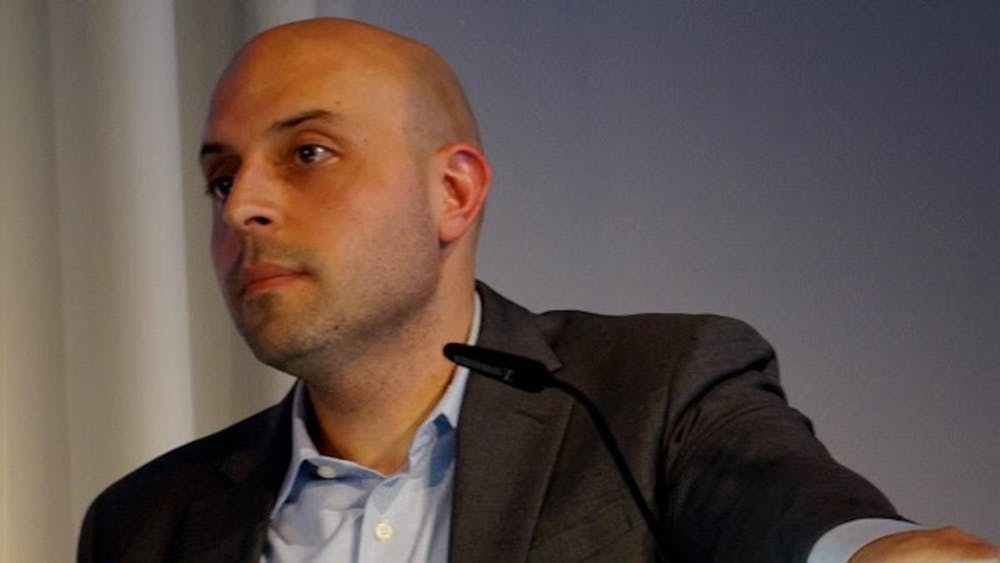Let's face it: Swedish art films are weird. Much of what comes out of Sweden is weird — Swedish meatballs, Swedish Fish (why are they so red?), those self assembly Ikea chairs, Zlatan Ibrahimović. But as far as weirdness goes, Swedish cinema takes the cake. I had the disconcerting pleasure of watching a Swedish art film this past weekend at DPAC. It was the third installment of director Roy Andersson's film trilogy that explores the human condition. Film number three did have the decency of broadcasting its oddity upfront with its sentence-long title: "A Pigeon Sat on a Branch and Reflected on Existence." It's probably one of the best films I've seen in the last few months. Granted, the last few months have been something of moviegoing dry-spell for me. I watched the 1999 comedy "Office Space" in low resolution with distorted sound quality in a dorm room and caught part of that Showtime series on Notre Dame football, which isn't really feature-length cinema anyways. But none of that should detract from the fact that, while sitting in Browning Cinema watching Andersson's bizarre film, I felt deeply moved. The film is, well, oddly good in a totally non-conventional way. There is no easily traced plot, no A-list lead, no camera movement to speak of. It's just 30 or so vignettes in sterile Swedish urban settings, each shot from a fixed camera angle. Rarely does one scene connect smoothly to another; here a man lies dead after a heart attack on a ferry; there a corpulent dance instructor repeatedly gropes her silent student. What can we make of these fragments? Where's the method in this madness? I thought movies were supposed to tell stories, not confuse their audiences with a chain of coincidences, signifying nothing. But this un-arranged form, this series of banal interactions is precisely what makes this film great. I contend that this film's fractured style captures a crucial feature of modern life, namely, its lack of an apparent end goal. Where is the climax towards which the individual or collective life is moving? If we look to generic cultural narratives in the modern West, it seems that we're just supposed to pursue some amorphous source of success or self-achievement. Put more crudely, we're supposed to get a good job, buy a nice house and maybe raise a family. But there's no overarching narrative, no linear plot pushing toward some higher aim. Like the characters in Andersson's film, “modern” men are plodding through the unchained events of life, riddling away what it all might mean. That's most of what happens in Andersson's film, except the riddling is rarely externalized. The film's characters consistently fail to communicate, missing the links between things. Two salesmen, who are among the few recurrent characters from scene to scene, keep thinking they'll be able to sell their strange novelty items — extra-long vampire fangs, laughing boxes and a plastic mask — if they just give their rehearsed spiel again and again. But all of a sudden, surreal and strange things intrude on the everyday weirdness of Swedish streets. An eighteenth-century royal army invades a bar on horseback where the salesmen have come seeking direction (figuratively as well as literally). Another scene simply shows a monkey undergoing electric shocks while a nurse talks on the phone and a man sweeps the hall on the other side of a glass door. A chattel of African slaves are marched at whip-point into an enormous galvanized barrel studded with what look like Sousaphone horns. For once, the camera shifts, and the reflection of the barrel is seen rotating over a fire. In the next scene, the more sympathetic of the two salesmen shouts down his apartment's hall to the night clerk: “Is it right using people only for your own pleasure?” He repeats the question several times. The night clerk fails to understand. If the film has a prevailing message, it is this: We frequently fail to take notice of the needs of other people. We are too much trapped in ourselves. In one of the few openly reflective scenes in the film, an old Swede shouts across to the barmaid that in his whole life, he's never cared about other people, and only now does he realize that his unhappiness stems from that. Attending a film like this forces you to work, to really pay attention to characters rather than having all the relevant information pieced together for you. It all makes me think that these odd Swedish art films are on to something. Maybe moviegoing — and art in general — should not passively entertain or content us, as the next Hollywood rom-com or action flick aims to do. Art should challenge us and force us to consider how and where we stand in relation to other people.
Charlie Ducey is a senior studying the languages of G. K. Chesterton (English) and Edith Stein (German). Please contact him with questions, comments, complaints, appraisals, invitations, prognostications and prestidigitations at cducey@nd.edu













